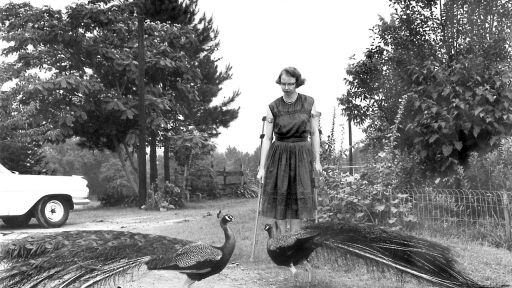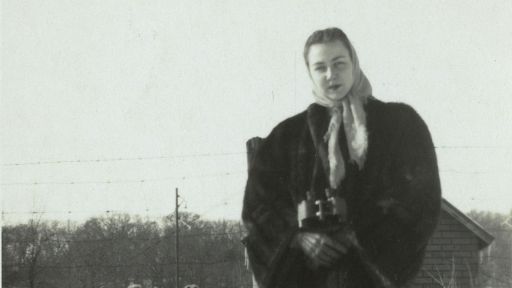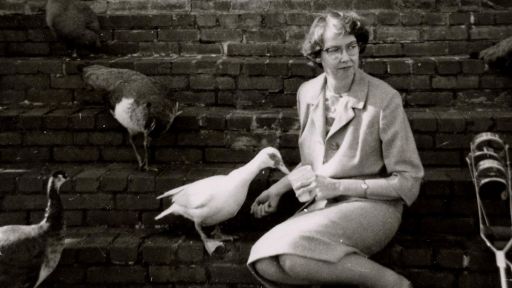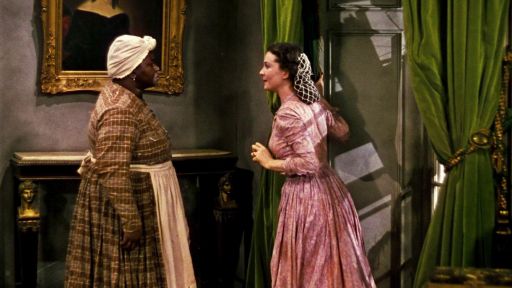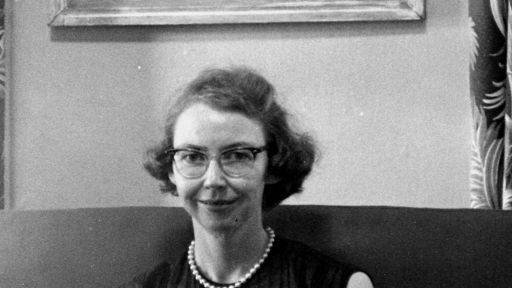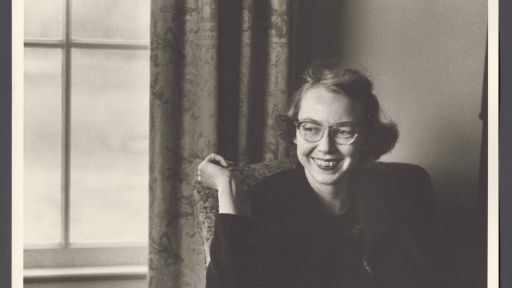From McSweeney’s, 2013
Race and faith and their attendant hierarchies and delusions are O’Connor’s great themes. She was hailed for her artistic and social independence, but readings of this American master often overlook the originality and honesty of her portrayal of Southern whiteness. Or, rather, Southern whiteness as it chafed under its biggest cultural influence – Southern Blackness. It’s remarkable to consider that O’Connor started writing less than a hundred years after Harriet Beecher Stowe published “Uncle Tom’s Cabin,” and just a decade after Margaret Mitchell’s “Gone with the Wind,” two books whose imagined Black worlds had more to do with their authors’ patronizing sentimentality than with the complicated intertwining of Black and white, rich and poor, mundane and sublime that characterized real Southern life – and O’Connor’s portrait of it. Her Black characters are not symbols defined in opposition to whiteness; they are the living people who were, physically at least, on the periphery of O’Connor’s own world. She was not romantic enough to rake Faulkner’s Dilsey view of Blacks – as the fulcrum of integrity and compassion. She didn’t use them as vessels of sympathy or scorn; she simply – and complexly – drew from life.
Flannery O’Connor’s electric vision is still surprising enough, nearly 90 years after her birth, to have inspired five critical studies in the year 2000 alone – the most compelling of which are Richard Giannone’s “Flannery O’Connor, Hermit Novelist” and Lorine M. Getz’s “Flannery O’Connor, Literary Theologian.” But one hesitates to read her fiction autobiographically; it was not an approach O’Connor had much patience for. “I know some folks that don’t mind their own bisnis,” she wrote when she was 12. Eighteen years later, she elaborated, in a letter to a friend, explaining why she had no interest in representing herself in writing:
To say that any complete denudation of the writer occurs in the successful work is, according to me, a romantic exaggeration. A great part of the art of it is precisely in seeing that this does not happen… Everything has to be subordinated to a whole which is not you. Any story I reveal myself completely in will be a bad story.
From the beginning, O’Connor worked to alchemize her background into something beyond mere anecdote and eccentricity. Born in 1925 in Savannah, Georgia, she was baptized Mary Flannery O’Connor at the Catholic Cathedral of St. John the Baptist. The Church’s sanctioning of mysticism would later have a profound influence on O’Connor’s writing, but Catholicism was a faith that had little sway in the “Christ-haunted” South O’Connor grew up in – a place where Jesus was God. Savannah had been settled first by Episcopalians and Lutherans, then by Baptists and Methodists; Catholics were excluded from the state’s charter until 1794, and were thereafter rarely regarded as anything but an itinerant non-Reformed sect, as alien a presence as the Jews. (‘That must be Jew singing,” someone scoffs when two Catholic girls sing psalms in the 1954 O’Connor short story “A Temple of the Holy Ghost.”)
American genius often feeds on its own environs, and O’Connor was no exception. “I’m pleased to live in Baldwin County in the sovereign state of Georgia, and to see what I can from here,” she told one interviewer. She knew where her material was, and had known it since she was 12. By then she had discovered the tone of her voice, too, its lyrical flatness and its wildly leaping humor. (“If I… tried to write a story about the Japanese, the characters would all talk like Herman Talmadge,” she once said.) O’Connor was already slipping verse under her father’s napkin at the table and rejecting books that didn’t satisfy her interest in the heretical. “Awful. I wouldn’t read this book,” she wrote in her copy of “Alice’s Adventures in Wonderland.” In a copy of “Georgia Finds Herself,” by Shirley Watkins: ‘This is the worst book I ever read next to Pinocchio.” About her early reading, O’Connor wrote to a friend in 1955:
The only good things I read when I was a child were the Greek and Roman myths which I got out of a set of a child’s encyclopedia… The rest of what I read was Slop with a capital S. The Slop period was followed by the Edgar Allan Poe period which lasted for years and consisted chiefly in a volume called The Humerous Tales of E.A. Poe. These were mighty humerous — one about a young man who was too vain to wear his glasses and consequently married his grandmother by accident; another about a fine figure of a man who in his room removed wooden arms, wooden legs, hair piece, artificial teeth, voice box, etc. etc.
From the beginning of her reading life, O’Connor preferred stories that were direct in their telling and mysterious only in their subtexts. She clearly despised the lack of clarity which she believed came with Northern liberalism, and which she lampoons with her intellectual characters, who always function in a kind of godless oligarchy. In many of her stories, intellectuals are depicted as grumpy poseurs, mean and homely failures who can’t get on with life and are often driven into the ground by its brutality. O’Connor was like her chicken, walking backward, staring at others as she removed herself from them.
In 1938, after Edward O’Connor was appointed a zone real estate appraiser for the Federal Housing Administration in Atlanta, Regina and Flannery moved into the Cline family house in the nearby town of Milledgeville, where Edward could visit on the weekends. There was no parochial education for Flannery in Milledgeville, the home of the state insane asylum. (She eventually graduated from the experimental Peabody High School.) And, soon after the move, Edward’s health began to deteriorate. He was suffering from lupus, a disease in which the body attacks its own tissues, destroying itself. Fifteen years after her father’s death, in 1941, O’Connor wrote to her friend Elizabeth Hester, a clerk at a credit bureau in Atlanta and a frequent correspondent during the last nine years of O’Connor’s life, whose identity was only recently revealed:
My father wanted to write but had not the time or money or training or any of the opportunities I have had… Anyway, whatever I do in the way of writing makes me extra happy in the thought that it is a fulfillment of what he wanted to do himself.
That fulfillment came relatively quickly. In 1945, shortly before completing her A.B. at the Georgia State College for Women, O’Connor was admitted to the State University of Iowa with a scholarship in journalism. O’Connor had clear, pale skin, a heart-shaped face, lively eyes, and a thick Georgia accent. In a letter to the editor Robert Giroux, Paul Engle, then the director of the Iowa Writers’ Workshop, recalls meeting her that fall and being unable to understand her speech: “Embarrassed, I asked her to write down what she had just said on a pad. She wrote: ‘My name is Flannery O’Connor. I am not a journalist. Can I come to the Writers’ Workshop?”‘ Engle continued:
Like Keats, who spoke Cockney but wrote the purest sounds in English, Flannery spoke a dialect beyond instant comprehension but on the page her prose was imaginative, tough, alive… Sitting at the back of the room silent, Flannery was more of a presence than the exuberant talkers who serenade every writing class with their loudness.
O’Connor rarely if ever discussed her “bisnis” – her religion, her writing, her Southernness – with her peers in Iowa. One classmate claims not to have realized that O’Connor “really did believe in evil and damnation and redemption” until she produced a story that showed insight into a character’s fall. O’Connor’s parochialism might have been a defense; the armor she used to shield herself from other people, but she also seemed to view it as someone else’s problem; she knew who she was and where she was going. Iowa, at last, provided her with a new perspective on the cryptic idea of home.
At the end of her first year at Iowa, O’Connor published her first story, “The Geranium,” in Accent. The story focuses on an enfeebled man named Old Dudley who is living up North with his daughter and her family but wants to go back home to the South to die, near the “n—–s” who are kinder to the old man than his own children. O’Connor reworked the story several times after its first publica- tion, but already, at 21, she had found many of her mature themes: the skewering of tradition, the erosion of one world that, disastrously, comically, is the weak foundation of the next, and the spectacle of Blacks and whites regarding each other across a divide of mutual outsiderness. O’Connor was not a polemicist, but her work is implicitly political given the environment she drew from – the South during its second failed attempt at Reconstruction, otherwise known as Integration. As she wrote in an essay titled “The Regional Writer,” “Southern identity is not really connected with mocking birds and beaten biscuits and white columns any more than it is with hookworm and bare feet and muddy clay roads.” Indeed, she was at times violently critical of Tennessee William’s and Carson McCullers’s work, because she felt that they played on cliched images of the region. “An identity is not to be found on the surface,” she wrote.
O’Connor’s vision of the postindustrial South with its Winn Dixie stores, its automobiles piled up in the junkyard of the Lord as a modem version of the fall was all her own. But what fall? What loss of innocence? That of the slaves who became indentured servants and then “n—–s,” and who dot her pages like flies? No: in O’Connor’s fictional universe, the whites in power are the only ones who can afford to be innocent of their surroundings. O’Connor’s most profound gift was her ability to describe impartially the bourgeoisie she was born into, to depict with humor and without judgment her rapidly crumbling social order. In ”Revelation,” a 1964 story, she described Mrs. Turpin, a woman who occupies herself “with the question of who she would have chosen to be if she couldn’t have been herself”:
If Jesus had said to her before he made her, “There’s only two places available for you. You can either be a n—-r or white trash,” what would she have said?… She would have wiggled and squirmed and begged and pleaded but it would have been no use and finally she would have said, “All right, make me a nigger then – but that don’t mean a trashy one.” And he would have made her a neat clean respectable Negro woman, herself but Black.”
When Mrs. Turpin gets into a fight with a young white woman from Wellesley while sitting in a doctor’s waiting room, her sense of propriety is upset; meaninglessness yawns before her like a great black hole. O’Connor allows us to see what Mrs. Turpin’s pride hides from her: how the Blacks who work for her condescend to her, how they hide their intelligence so that she won’t be tempted to interfere in their lives. One of them asks Mrs. Turpin about the bruise she incurred during the fight and, before she can explain, continues,
“Ain’t nothing bad happen to yout” the old woman said. She said it as if they all knew that Mrs. Turpin was protected in some special way by Divine Providence. “You just had you a little fall.”
Mrs. Turpin describes the scene in the doctor’s office:
“She said… something real ugly,” she muttered.
”She sho shouldn’t said nothin ugly to you,” the old woman said.
”You so sweet. You the sweetest lady I know.”
“She pretty too,” the one with the hat on said.
“And stout,” the other one said. “I never knowed no sweeter white lady.”
“That’s the truth befo’ Jesus,” the old woman said. “Amen. You des as sweet and pretty as you can be.”
Mrs. Turpin knew exactly how much Negro flattery was worth and it added to her rage. “She said,” she began again and finished this time with a fierce rush of breath, “that I was an old wart hog from hell.”
There was an astounded silence.
“Where she at?” the youngest woman cried in a piercing voice. “Lemme seeher. I’ll kill her!”
“I’ll kill her with you!” the other one cried.
“She b’long in the sylum,” the old woman said emphatically.
“You the sweetest white lady I know.”
“She pretty too,” the other two said. “Stout as she can be and sweet. Jesus satisfied with her!”
Jesus is, perhaps, not as satisfied as Mrs. Turpin. No reader can help but be amused and disturbed by this passage, which is representative of O’Connor’s subtle observation of a world that was not her own but that informed every inch of the one she inhabited. Blacks may have spent much of their lives on the margins, but she understood the ways in which they entered the circle. The theatrical modesty and duplicity exhibited by these Blacks who are an audience for Mrs. Turpin’s troubles despite the fact that she will never be one for theirs are all just a part of the Southern code of manners.
O’Connor delighted in portraying the forms of domestic terrorism. It is a Catholic tenet that God judges by actions, but virtually all her white woman characters judge by appearances. O’Connor greatly admired Faulkner. ”Nobody wants his mule and wagon stalled on the same track the Dixie Limited is roaring down,” she remarked of Southern writers’ relationship to the Master. But there is no Faulknerian Snopes in O’Connor’s fiction. What she describes is far more evil: the nice lady on the bus who calls you “n—-r” by offering your child a penny; or the old woman who loves to regale her grandchildren with stories about the “pickaninnies” of her antebellum youth. These are women who wouldn’t know grace if it slapped them in the face – which it often does. And why would any Black person want to belong to the world that these women and their men have created?
For O’Connor, writing about integration was a way of exposing the dangers of clinging to the fiction of power. But like Faulkner, O’Connor herself had difficulty assimilating the push toward integration that took the region so suddenly and violently in the ’50s and ’60s.
She clung to the provincialism she satirized, and she was sometimes clumsy at conveying real life among Blacks beyond her own circles – their class distinctions, their communication with one another apart from whites. The one false note in “The Displaced Person” (1955), for instance, comes when two Black workers discussing the woman they work for fall into a kind of rural Amos ‘n’ Andy routine: “‘Big Belly act like she know everything.’ ‘Never mind… your place too low for anybody to dispute with you for it.'” A curtain falls over O’Connor’s insight-and her ear for speech. Luckily, she rarely tried to cover this ground, probably a prudent decision, given the murky and not altogether constructive works of some of the white liberals who did.
O’Connor received her MFA in June of 1947, and Engle arranged for a fellowship that allowed her to stay at Iowa for another year and begin work on her unsettling first novel, “Wise Blood.” Hazel Motes, O’Connor’s Evangelical hero, wears a blue shirt and a black hat and has white skin that crackles like pork rind in the hot Southern sun. He may look like a standard preacher, but he’s not like any the good citizens of his adopted town, Taulkiriham, have ever heard of. An itinerant prophet, he believes only in his own church, “The Church Without Christ… where the blind don’t see and the lame don’t walk and what’s dead stays that way.” Motes is a backward innocent, raised a Baptist, who, instead of accepting Christ into his life, decides to be him. By denying Jesus, he runs his back on those who came before him and who no doubt learned much of their discourse from the Black preachers whose rhetoric soaks the Southern soil. But Motes has a grudge against Jesus: He equates Him with sin, or more specifically with the sins that he himself has committed and cannot escape – not in the eyes of his relatives, rotten with fake piety, who believe that only the Lord can wash him clean and are no better than niggers who think that the Lord will make them white.
Of “Wise Blood,” the writer and critic Stanley Edgar Hyman said, “Whatever caused Miss O’Connor to choose Protestant Fundamentalism as her metaphor for Catholic vision, it was a brilliant choice… It freed her from the constraints of good taste.” O’Connor’s humor lay in such paradoxes – in being an alienated Catholic in a world of Bible thumpers, a single girl in a society of matrons. “It becomes more and more difficult in America to make belief believable, but in this the Southern writer has the greatest possible advantage. He lives in the Bible Belt,” she wrote, and went on:
The Catholic novelist in the South is forced to follow the spirit into strange places and to recognize it in many forms not totally congenial to him…! think he will feel a good deal more kinship with backwoods prophets and shouting fundamentalists than he will with those politer elements for whom the supernatural is an embarrassment and for whom religion has become a department or sociology or culture of personality development. His interest and sympathy may very well go – as I know my own does – directly to those aspects of Southern life where the religious feeling is most intense and where its outward forms are farthest from the Catholic… The result of these underground religious affinities will be a strange and, to many, perverse fiction, one which… gives us no picture of Catholic life, or the religious experiences that are usual with us, but I believe that it will be Catholic fiction.
In 1948, she was accepted at Yaddo as a writer in residence. There she was championed by several other writers: Alfred Kazin, Robert Lowell, and Lowell’s wife to-be, Elizabeth Hardwick, who once described O’Connor as being “like some quiet, puritanical convent girl from the harsh provinces of Canada.” Although Philip Rahv eventually published O’Connor’s work in the Partisan Review, she first began to attract attention in the Sewanee Review and, through the Southern Agrarian John Crowe Ransom, in the Kenyon Review. With the exception of Kazin, virtually none of O’Connor’s early supporters were Jewish, and O’Connor had little exposure to European immigrants, to intellectual debate as a form of socializing, or to agnosticism. The North was still a black-and-white world, though in a different way than she’d experienced it at home.
The following year, O’Connor secured a contract for “Wise Blood,” with Holt, Rinehart. The association was not a happy one. She wrote to Paul Engle, describing the experience:
I learned indirectly that nobody at Rinehart liked the 108 pages… that the ladies there particularly had thought it unpleasant (which pleased me). I told Selby [O’Connor’s editor] that I was willing enough to listen to Rinehart’s criticism but that if it didn’t suit me, I would disregard it… To develop at all as a writer I have to develop in my own way… I will not be hurried or directed by Rinehart. I think they are interested in the conventional and I have had no indication that they are very bright… If they don’t feel I am worth giving more money to and leaving alone, then they should let me go… Selby and I came to the conclusion that I was “prematurely arrogant.” I supplied him with the phrase.
It is incredible to read, in this age, a letter by a writer whose use of ego serves to protect, not inform, her work. O’Connor was soon released from her contract and, in 1950, signed with Robert Giroux, then at Harcourt, Brace, whom she had met through Robert Lowell. The year before, Lowell had also introduced her to the Catholic poet and translator Robert Fitzgerald and his wife, Sally. The young couple had children and a home in Ridgefield, Connecticut; they needed a boarder to make ends meet, and O’Connor moved in that fall. O’Connor attended Mass daily with the Fitzgeralds. And, as her literary mastery deepened, she became better able to define her faith. She wrote to Elizabeth Hester: “I am a Catholic peculiarly possessed of the modern consciousness, that thing Jung describes as unhistorical, solitary, and guilty. To possess this within the Church is to bear a burden, the necessary burden for the conscious Catholic.”
As W.H. Auden put it, “In 1912, it was a real vision to discover that God loves a Pernod and a good f—, but in 1942 every maiden aunt knows this and it’s time to discover something else He loves.” Unlike the majority of Catholics the Fitzgeralds had known, O’Connor lived her faith. In a memoir about her, Robert Fitzgerald wrote admiringly of her inability to speak in abstractions: “She could make things fiercely 0 plain, as in her comment, now legendary, on an interesting discussion of the Eucharist Symbol: ‘If it were only a symbol, I’d say to hell with it.”
This most psychologically astute and least “psychological” of writers watched the action unfold in her stories and novels with a kind of amateur glee. As someone whose worldview was in part ecclesiastical, O’Connor also knew that having faith involved hard, often dispassionate work: You did not embrace the leper at the side of the road because you “identified” with him; in fact, “because” wasn’t even part of the equation. Seeing his skin drop off in flakes and handing over a fiver to sustain him were actions that called for description, not explanation. O’Connor understood comedy as the flashy side of tragedy. In her work, disaster puts on a red shirt and acts the fool for the Devil’s amusement.
In 1950, while typing the first draft of “Wise Blood,” O’Connor began to experience a heaviness in her arms. She was diagnosed with rheumatoid arthritis. But later that year she became seriously ill. She was suffering from lupus, the disease that had killed her father. Lupus put her in and out of hospitals for the rest of her life. It caused her face to swell and her hair to fall out; it required her to give herself injections of cortisone, and, eventually, to walk with aluminum crutches because “the misery,” as she termed it, affected her hips.
Except for a few speaking engagements and a visit to Europe with her mother, which included a pilgrimage to Lourdes (“I am going as a pilgrim, not a patient,” she wrote. “I will not be taking any bath. I am one of those people who could die for his religion easier than take a bath for it.”). O’Connor lived from 1952 until her death, in 1964 – at age 39 – near Milledgeville, on Andalusia, a dairy farm that her mother had inherited. There she raised peacocks and ran a theology and literature reading group. She also wrote “The Violent Bear It Away,” and the stories that appeared in “A Good Man Is Hard to Find” and “Everything That Rises Must Converge.” These stories glisten with intelligence and with startling anti-solipsism: She describes, never preaches.
O’Connor may have found comfort in her religion, which allowed her to enter into a dialogue with God about suffering. But she was surprisingly intolerant of the religious struggle of others, particularly that of women intellectuals. “The life of this remarkable woman… intrigues me while much of what she writes, naturally, is ridiculous to me,” O’Connor wrote of Simone Weil, a Jew who immersed herself in Catholicism. “Weil’s life is the most comical life I have ever read about… If I were to live long enough and develop as an artist to the proper extent, I would like to write a comic novel about a woman – and what is more comic and terrible than the angular intellectual proud woman approaching God inch by inch with ground teeth?” Was O’Connor instinctively recoiling from her own reflection in the mirror?
O’Connor, in return, was viewed as “homely” by most women of her time. Feminists have long looked up to her for her lack of compromise and her relative isolation, but they rarely factor in the emotional toll both took on her and her work or the painful rewriting O’Connor has had to endure at the hands of memoirists such as Katherine Anne Porter, who emphasize how attractive she was, as if a woman must balance intelligence with prettiness to be legitimate. What was lacking in O’Connor’s life – and in her art – was the spontaneous experience of intimate love, with its attendant joys and tedium and security. In O’Connor’s fictional world, carnality, when it comes up at all, is brutal and hilariously symbolic. Mr. Shortly, in “The Displaced Person,” for instance, “makes love” to his wife by placing a lit cigarette inside his mouth like the tip of the Devil’s tail:
When he had done his courting, he had not brought a guitar to strum or anything pretty for her to keep, but had sat on her porch steps, not saying a word, imitating a paralyzed man propped up to enjoy a cigarette. When the cigarette got the proper size, he would turn his eyes to her and open his mouth and draw in the butt and then sit there as if he has swallowed it, looking at her with the most loving look anybody could imagine. It nearly drove her wild and every time he did it, she wanted to pull his hat down over his eyes and hug him to death.
Sally Fitzgerald noted in a chronology that accompanies “O’Connor’s Collected Works” (1988) that in the early ’50s O’Connor had been in love with a visiting Danish textbook editor, but there is scant reference to him in the selected letters, “The Habit of Being” (1979), which was overseen by O’Connor’s protective mother. Regina O’Connor’s deep-seated respect for the social hierarchy created a gap between her and her daughter, and Flannery wrote amusingly in letters to friends about Regina’s efforts to bridge it. In a 1953 letter to the Fitzgeralds:
My mamma and I have interesting literary discussions like the following which took place over some modem library books that I had just ordered:
SHE: “Mobby Dick. I’ve always heard about that”
ME: “Mow-by Dick.”
SHE: “Mow-by Dick. The Idiot. You would get something called Idiot. What’s it about?”
ME: “An idiot.”
Much is left out or elided in the selected correspondence, the rights to which Regina controlled until her death, in 1995. But on the matter of faith the letters are often fierce and beautiful. The most conclusive statement appears in a letter written in the summer of 1955, to Hester:
If you live today you breathe in nihilism. In or out of the Church, it’s the gas you breathe. If I hadn’t had the Church to fight it with or to tell me the necessity of fighting it, I would be the stinkingest logical positivist you ever saw right now. With such a current to write against, the result almost has to be negative. It does well just to be. Then another thing, what one has as a born Catholic is something given and accepted before it is experienced. I am only slowly coming to experience things that I have all along accepted. I suppose the fullest writing comes from what has been accepted and experienced both and that I have just not got that far yet all the time. Conviction without experience makes for harshness.
And yet she would have little by way of experience for the next nine years. Visitors came through Milledgeville. Admirers wrote letters. But as the years went on, O’Connor’s view of what Marianne Moore called “the strange experience of beauty” became the subject of her jokes, not of serious examination. Like many people crippled by illness, O’Connor cleaved to the world as she knew it. In her early work, she had taken an intense interest in hustlers and freaks and “n—–s.” ”Whenever I am asked why Southern writers particularly have this penchant for writing about freaks, I say it is because we are still able to recognize one,” she said once. But as her lupus progressed she spent less and less time discussing identity and its political implications, and, when she did, it often felt cavalier. “No I can’t see James Baldwin in Georgia,” she wrote in 1959 to a friend who had tried to arrange the introduction. “It would cause the greatest trouble and disturbance and disunion. In New York it would be nice to meet him; here it would not. I observe the traditions of the society I feed on – it’s only fair. Might as well expect a mule to fly as me to see James Baldwin in Georgia.” One feels a sense of loss on reading this, not only because of what such a union might have produced but also because of the limitations of O’Connor’s time and place and the inevitable restrictions they placed on her art. Her regionalism was both a strength and a weakness; the emotional distance caused by her physical suffering was the axis on which both her comedy and her cruelty turned.
Had O’Connor and Baldwin met, they could have laughed together about their particular “Christ hauntings”: Baldwin was the son of a minister and had preached himself; his experience was not so different from that of the mad, naïve evangelists who populate O’Connor’s fiction. And what a discussion they could have had about whiteness! In 1955, after a stay at an all-white Swiss village, Baldwin wrote, “This world is white no longer, and it will never be white again” – meaning that Blacks, as artists and men, could no longer be confined to the self-contained enclaves that had produced them. O’Connor’s later fiction was, in large part, an acknowledgment of this, and of the fear and fury it produced in her world. That conversation is lost to history. But O’Connor’s work is not. One can hear her syntax and thoughts in the stories of Raymond Carver, in Robert Duvall’s brilliant movie “The Apostle,” in the Samuel L. Jackson character’s final monologue in “Pulp Fiction.” Her work has moved away from the South as she defined and knew it, all the way to Hollywood, where Americans have embraced it, hearing in O’Connor’s voice her uneasy and unavoidable union between Black and white, the sacred and the profane, the s— and the stars.


